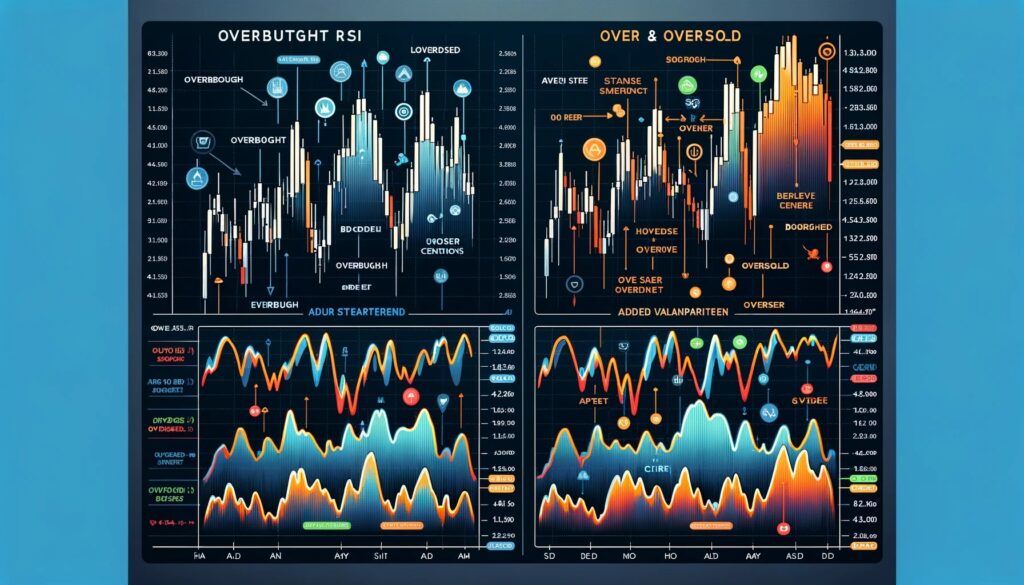The Relative Strength Index (RSI) is a cornerstone in the toolkit of Forex traders, offering nuanced insights into market momentum and potential price reversals. Developed by J. Welles Wilder Jr., this momentum oscillator fluctuates between 0 and 100, signaling overbought or oversold conditions and providing traders with critical information to guide their decisions. This blog post will embark on an extensive exploration of the RSI, breaking down its mechanics, application in Forex analysis, and strategic incorporation into trading methodologies.
Decoding the Relative Strength Index
Fundamentals of Relative Strength Index (RSI)
The RSI is calculated based on average price gains and losses over a specified period, typically 14 days. By comparing the magnitude of recent gains to recent losses, the RSI quantifies the speed and change of price movements, rendering a dynamic picture of market sentiment and momentum.
Interpreting RSI Readings in Forex Markets
An RSI reading over 70 suggests an overbought condition, signaling traders that a downturn may be imminent as the currency pair could be overvalued. Conversely, an RSI below 30 indicates an oversold condition, hinting at a potential upward correction as the pair might be undervalued. These thresholds are pivotal for traders aiming to capitalize on market reversals.

Advanced Strategies Using RSI
Spotting Divergences for Reversal Opportunities
Divergence with the RSI is a powerful indicator of potential market reversals. A bullish divergence occurs when the currency price hits a new low, but the RSI forms a higher low, indicating weakening downward momentum. A bearish divergence happens when the price reaches a new high, but the RSI forms a lower high, signaling fading upward momentum.
Overbought and Oversold: Beyond the Basics
While the 70 and 30 levels are standard for identifying overbought and oversold conditions, adjusting these thresholds can refine analysis. In highly volatile markets, settings of 80 and 20 may reduce false signals, aligning more closely with extreme market conditions.
RSI Swing Rejections: A Tactical Approach
Swing rejection is a lesser-known but effective RSI strategy. It involves four stages:
- RSI falls into the oversold/overbought territory.
- RSI crosses back above/below the 30/70 threshold.
- RSI forms another dip without crossing back into oversold/overbought territory, creating a double bottom/top pattern.
- The RSI breaks past the peak of the initial rebound, confirming a swing rejection signal.

Incorporating RSI into Comprehensive Market Analysis
Case Study: Trading EUR/USD Using RSI
Imagine the EUR/USD pair is on a downtrend, with RSI readings persistently below 30. Suddenly, the RSI starts to diverge, forming higher lows while prices continue to chart lower lows. This bullish divergence could signal traders to prepare for a potential upward reversal. If the RSI then crosses above 30, it could serve as a confirmation to enter a long position, with stop losses placed below the recent price low.
Synergizing RSI with Other Indicators
For a holistic analysis, traders often pair the RSI with other technical indicators. For instance, using the RSI in conjunction with moving averages can offer dual confirmation of trend directions. When a moving average crossover coincides with an RSI exit from overbought or oversold territory, it strengthens the case for entry or exit.

Optimizing RSI Use for Forex Trading
Customizing RSI Settings for Market Conditions
While the default 14-period setting is widely used, tailoring the period based on the currency pair’s volatility and one’s trading timeframe can enhance the RSI’s effectiveness. Shorter periods can be used for a more sensitive oscillator that reacts quickly to price changes, suitable for short-term trading. Longer periods may suit swing traders or investors looking for more significant trend confirmation.
RSI: A Tool, Not a Standalone Solution
It’s critical to remember that the RSI, while powerful, should not be used in isolation. Combining RSI signals with fundamental analysis, price action, and other technical indicators creates a robust trading strategy that can navigate the complexities of the Forex market with greater accuracy and confidence.
Conclusion
The Relative Strength Index is more than just an indicator; it’s a versatile tool that, when mastered, can significantly augment a trader’s ability to analyze and react to Forex market dynamics. By understanding and applying the strategies outlined above, traders can leverage the RSI to identify potential reversals, gauge market momentum, and make informed trading decisions. As with any tool, the key to success lies in practice, continuous learning, and integrating the RSI into a comprehensive, disciplined trading approach.

FAQs on Relative Strength Index (RSI) in Forex trading
What is the Relative Strength Index (RSI)?
The Relative Strength Index (RSI) is a momentum oscillator that measures the speed and change of price movements on a scale of 0 to 100. It was developed by J. Welles Wilder Jr. and is used to identify overbought or oversold conditions in the market, gauge the strength of a trend, and potentially signal reversals.
How is the Relative Strength Index (RSI) calculated?
The RSI is calculated using a formula that compares the average gains and the average losses over a specified period, typically 14 periods. The formula is: RSI = 100 – (100 / (1 + RS)), where RS is the average gain of up periods during the specified time frame divided by the average loss of down periods.
What do overbought and oversold levels indicate in Relative Strength Index (RSI)?
In RSI, overbought conditions are typically indicated by a reading above 70, suggesting that a currency pair might be overvalued and could be due for a reversal or pullback. Conversely, an oversold condition is indicated by a reading below 30, suggesting that a pair might be undervalued and could be due for a bounce or reversal to the upside.
Can the Relative Strength Index (RSI) be used to identify trends?
Yes, the RSI can be used to identify trends. When the RSI remains above 50, it can indicate an overall uptrend, while staying below 50 can signal a downtrend. However, RSI is primarily a momentum indicator, so it’s most effective when used in conjunction with other trend-following indicators or analysis techniques.
How can I use Relative Strength Index (RSI) divergence in trading?
RSI divergence occurs when the price of a currency pair and the RSI indicator move in opposite directions. This can be a powerful signal of a potential trend reversal. Bullish divergence happens when the price makes a new low, but the RSI makes a higher low, indicating weakening downward momentum. Bearish divergence occurs when the price makes a new high, but the RSI makes a lower high, indicating weakening upward momentum.
Is it better to adjust the standard 14-period setting on the Relative Strength Index (RSI)?
Adjusting the RSI period can make the indicator more or less sensitive to price movements. A shorter period (less than 14) will make the RSI more sensitive and may provide more signals, while a longer period (more than 14) will make it less sensitive, potentially offering more significant but fewer signals. The best setting depends on your trading style and the specific market conditions you are trading in.
How can I avoid false signals when using the Relative Strength Index (RSI)?
To reduce the likelihood of acting on false signals from the RSI, consider using it in conjunction with other indicators and analysis methods. For example, confirm RSI signals with trend lines, price patterns, or other technical indicators like moving averages. Additionally, incorporating price action and fundamental analysis can provide a more comprehensive view of the market.





